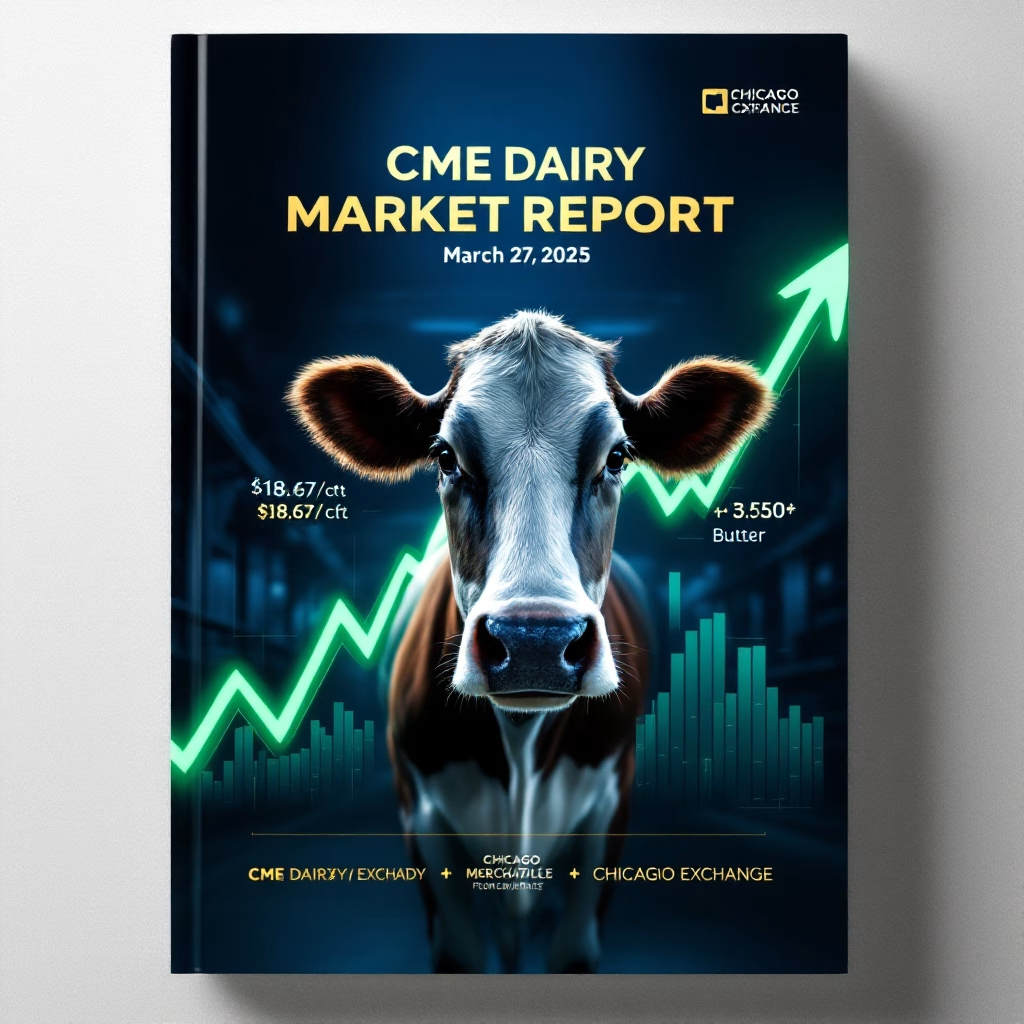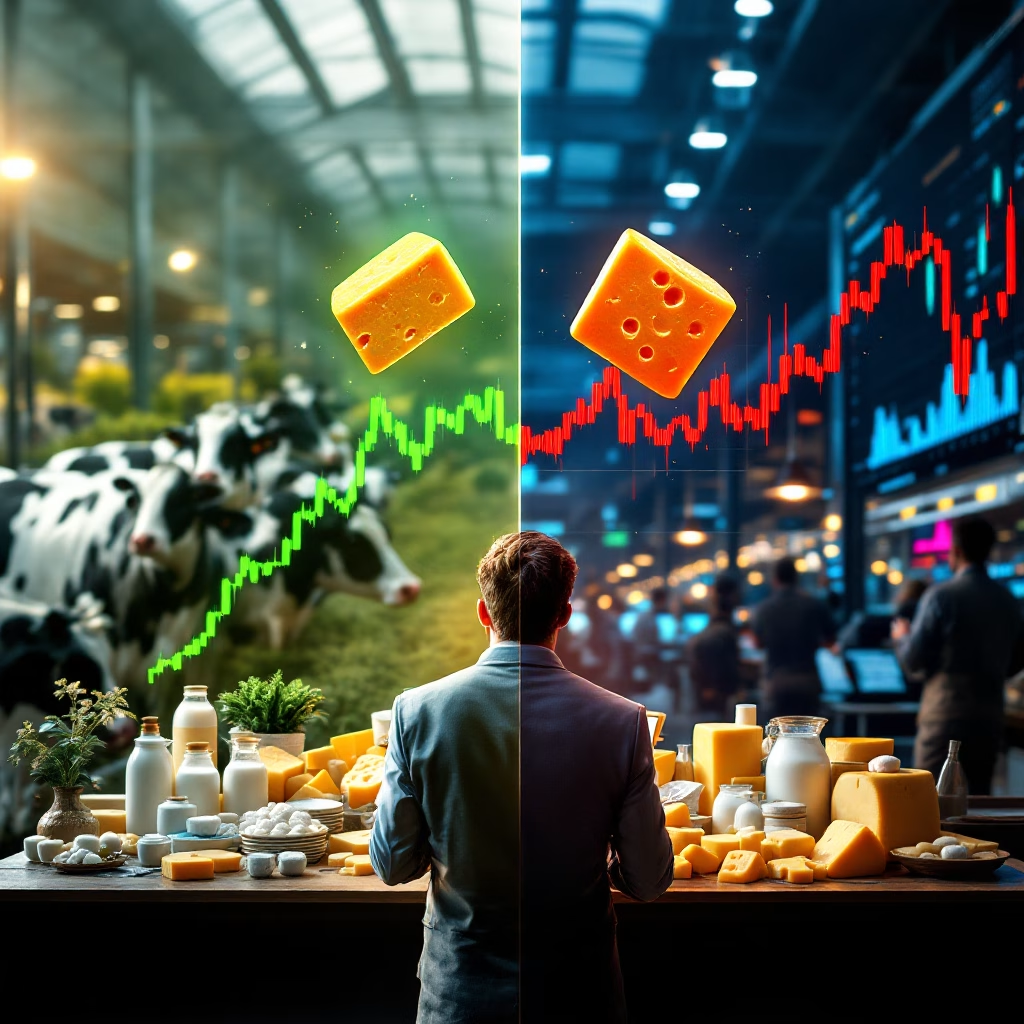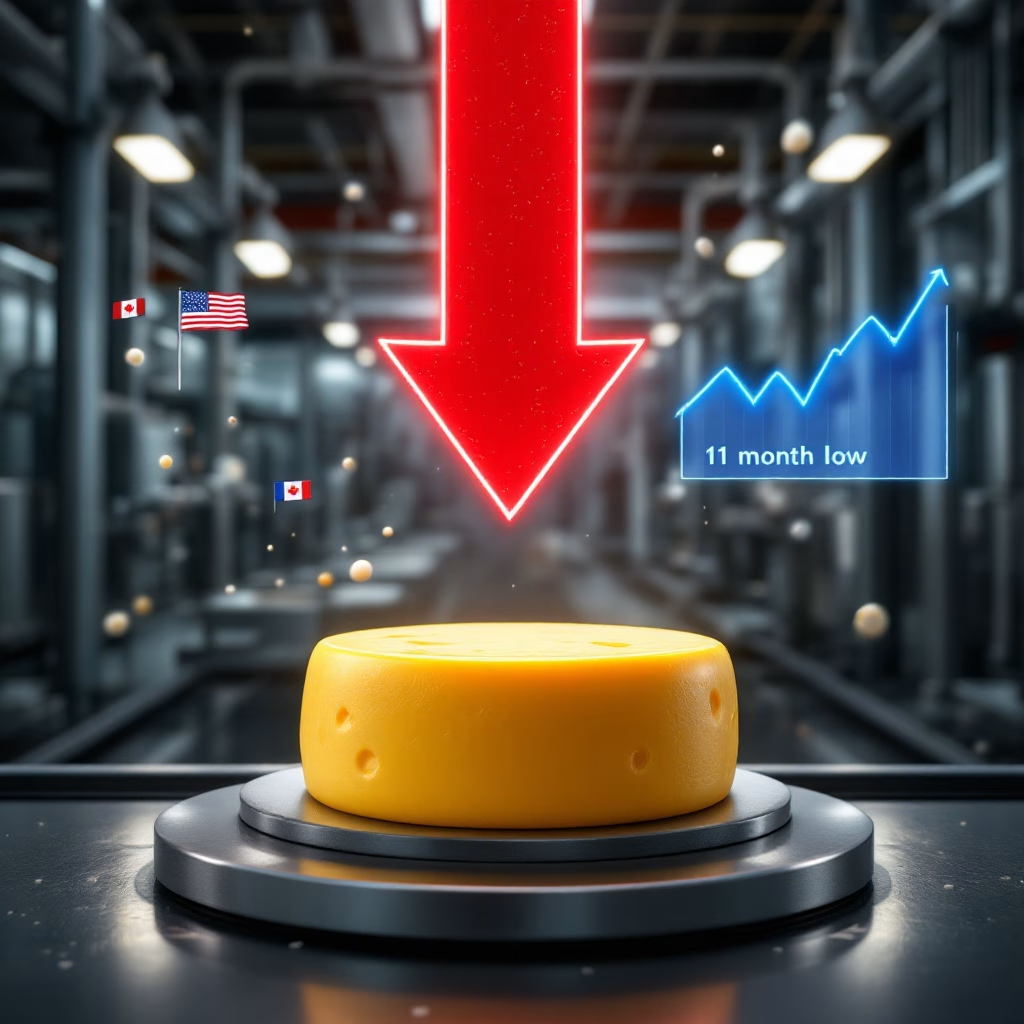Butter prices soar 3.5¢ despite high stocks as Class III milk futures rally past USDA forecasts. Global dairy markets brace for spring volatility.
EXECUTIVE SUMMARY: CME dairy markets saw significant bullish momentum on March 27, 2025, with butter leading gains (+3.50¢) despite elevated inventories and cheese blocks rising 1.75¢. Class III milk futures surged to .67/cwt, exceeding USDA projections by 17¢, signaling trader confidence in tightening supplies. Global dynamics diverged sharply, with EU milk production declining (-0.2%) amid regulatory pressures while New Zealand output grew (+3.1%). The USDA revised its 2025 all-milk price forecast upward to .75/cwt, though nonfat dry milk faced headwinds from global price competition. Stakeholders are advised to monitor feed costs, export opportunities, and Federal Order changes expected June 1.
KEY TAKEAWAYS
- Buter Defies Logic: Prices jumped 3.5¢ despite 17% monthly inventory growth, driven by technical buying and export speculation.
- Class III Futures Signal Strength: Settled at $18.67/cwt, 17¢ above USDA forecasts – largest premium since March 23.
- Global Split: EU milk production declines (-0.2%) contrast with New Zealand’s 3.1% growth, reshaping export opportunities.
- NDM at Crossroads: U.S. prices remain globally uncompetitive ($1.15/lb) despite USDA’s $1.30/lb annual projection.
- Action Items: Producers urged to hedge Class III exposure; processors warned about tightening butter supplies.

Butter and cheese markets showed significant strength in today’s Chicago Mercantile Exchange (CME) dairy trading, with butter posting the most crucial daily gain in nearly a month. Class III milk futures extended their rally, climbing to .67/cwt and widening the gap with USDA’s forecast. Meanwhile, after yesterday’s advance, nonfat dry milk retreated, reflecting the mixed signals currently driving dairy markets as seasonal spring flush approaches.
Key Price Changes & Market Trends
| Product | Closing Price | Change from Yesterday |
| Butter | $2.3650/lb | +3.50¢ |
| Cheese (Blocks) | $1.6475/lb | +1.75¢ |
| Cheese (Barrels) | $1.6350/lb | +0.50¢ |
| Nonfat Dry Milk | $1.1500/lb | -1.00¢ |
| Dry Whey | $0.4950/lb | -0.50¢ |
Butter led today’s advances with a significant 3.50¢ gain despite recent cold storage reports showing inventories at 305 million pounds (up 17% month-over-month and 3% year-over-year). This seemingly contradictory movement suggests technical buying and potential export interest override inventory concerns. Cheese blocks followed with a substantial 1.75¢ increase, continuing their upward trajectory since Monday and widening the spread with barrels to 1.25¢. Nonfat dry milk retreated 1¢ after yesterday’s 2¢ jump, while dry whey dipped slightly to close just under the psychological 50¢ threshold.
Volume and Trading Activity
Today’s session saw notably active trading in butter, with 15 trades executed, reflecting strong buyer interest despite higher prices. Cheese blocks also showed healthy activity with six trades and balanced bidding interest (4 bids, four offers), indicating genuine price discovery rather than unidirectional pressure. In contrast, barrels, NDM, and dry whey saw minimal trading with just one trade each, suggesting more cautious positioning in these markets.
Butter’s trading activity was particularly noteworthy given yesterday’s Cold Storage report findings. Buyers seemingly discounted the high inventory levels in favor of forward-looking market dynamics. The 15 trades completed represent the highest daily volume for butter this week.
Global Context
International factors continue to influence U.S. dairy markets, with the stronger dollar noted yesterday having a minimal dampening effect on today’s butter and cheese advances. Export competitiveness remains a key consideration, particularly as U.S. butter and cheese exports are projected to grow due to competitive pricing.
Global milk production patterns are evolving significantly in 2025. The European Union’s milk production is forecast to decrease by 0.2% to 149.4 million metric tons due to declining cow numbers, tight farmer margins, environmental regulations, and disease outbreaks. This contrasts with New Zealand, where milk production showed 3.1% seasonal growth through December 2024, driven by favorable weather conditions and improved farm profitability.
These divergent production trends create both challenges and opportunities for U.S. dairy exports. While EU cheese production is expected to increase by 0.6% to 10.8 million metric tons despite overall milk production declines, this shift toward higher-value products may create openings for U.S. exports in other categories like butter and powdered milk.
Forecasts and Analysis
Class III milk futures continued their impressive rally, settling at .67/cwt today. This is a significant 13¢ increase from Wednesday and is now solidly above the USDA forecast of $18.50/cwt. This marks the fourth consecutive day of gains for Class III futures and reflects market confidence in cheese values.
Class III Milk Futures vs USDA Forecast (Mar 2025)
The widening gap between actual futures prices and USDA projections suggests traders are pricing in stronger fundamentals than official forecasts currently recognize. Today’s Class III settlement at $18.67 represents a 17¢ premium to the USDA forecast, compared to just a 4¢ premium on Monday.
USDA’s broader 2025 dairy forecast includes an all-milk price projection of $22.75/cwt, recently revised upward due to strong demand for cheese and export opportunities. The current market trajectory aligns with this more optimistic outlook, particularly in the cheese and butter segments.
USDA has also adjusted its dairy herd size projection for 2025, increasing it by 5,000 head to 9.380 million while simultaneously lowering milk production forecasts to 226.2 billion pounds (-0.7 billion) due to slower-than-expected growth in output per cow. This production dynamic bears monitoring as we approach peak spring flush.
Market Sentiment
Despite yesterday’s mixed performance, Market sentiment has become increasingly bullish, particularly in the butter and cheese markets. Traders appear to be positioning for tighter supplies as we approach Q2, with one market analyst noting, “The significant butter trading volume today, combined with higher prices, suggests genuine concern about future availability despite current inventory levels.”
The continued strength in Class III futures reflects confidence in cheese demand fundamentals. Market participants seemingly discount the “processors outpacing demand” narrative mentioned in yesterday’s reports. Instead, the focus appears to be shifting toward potential supply constraints and strengthening demand as we move into late spring.
Given recent global developments, the nonfat dry milk (NDM) market deserves particular attention. While today saw a modest 1¢ decline, U.S. NDM prices have been among the highest globally in recent months, creating challenges for export competitiveness. The USDA projects non-fat dry milk prices in the U.S. to average $1.30/lb in 2025, representing a 5.4% increase from 2024. Today’s closing price of $1.15/lb suggests a potential upside if these projections materialize.
Closing Summary & Recommendations
In summary, today’s dairy markets showed substantial strength in butter and cheese prices, with butter gaining 3.50¢ despite high inventory levels and cheese blocks rising 1.75¢. Class III milk futures extended their rally to .67/cwt, now trading 17¢ above USDA’s .50/cwt forecast. The divergence between intense price action and previously reported inventory builds suggests markets are looking beyond current supplies to anticipated tightening conditions.
For Producers:
- Consider implementing selective hedging strategies for Class III milk as future prices have established a clear premium to USDA forecasts, potentially creating favorable pricing opportunities.
- Monitor feed costs closely. Recent weakness in corn and soybean futures could improve milk production margins.
- Track global production trends, particularly the declining EU milk production, and increasing New Zealand output, as these shifts will impact international market dynamics and potential export opportunities.
For Processors:
- Today’s active butter trading suggests increasing supply competition despite reported inventory levels. Forward contracting may be prudent before potential further price increases.
- The widening block-barrel spread (now 1.25¢) signals evolving market dynamics that may impact procurement strategies across cheese categories.
- Consider the implications of EU processors prioritizing cheese production at the expense of butter and powder, which could create opportunities in international markets.
For All Market Participants:
- Friday’s weekly summary report will provide crucial context for this week’s price movements and help establish whether today’s strength represents a new trend or temporary repositioning.
- Continue preparing for potential market volatility as Federal Order changes approach (June 1), which will fundamentally alter milk pricing formulas.
- Pay close attention to global dairy trade patterns, as China shows signs of demand recovery after years of declining dairy import volumes, potentially creating new export opportunities.
Read more:
- USDA’s 2025 Dairy Outlook: Market Shifts and Strategic Opportunities for Producers
Explains USDA’s revised milk production forecasts ($22.75/cwt all-milk price) and strategies for navigating tightening supplies and export dynamics. - Global Dairy Market Trends 2025: European Decline, US Expansion Reshaping Industry Landscape
Analyzes EU’s 0.2% milk production decline vs. U.S. growth, aligning with today’s discussion of international price pressures. - Good News for Dairy in 2025: Higher Milk Prices, Lower Feed Costs Ahead
Contextualizes today’s bullish Class III futures rally with USDA’s $52.1B milk receipts forecast and 10.1% feed cost reduction projections.
 Join the Revolution!
Join the Revolution!
Join over 30,000 successful dairy professionals who rely on Bullvine Daily for their competitive edge. Delivered directly to your inbox each week, our exclusive industry insights help you make smarter decisions while saving precious hours every week. Never miss critical updates on milk production trends, breakthrough technologies, and profit-boosting strategies that top producers are already implementing. Subscribe now to transform your dairy operation’s efficiency and profitability—your future success is just one click away.







 Join the Revolution!
Join the Revolution!















